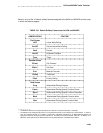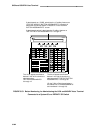
8434 and 8434DX Voice Terminal
Important: You do NOT need to change any settings on the voice terminal for 2-wire or
4-wire installations. The voice terminal is able to detect whether it is in a
2-wire or a 4-wire configuration.
For 2-wire operation, if you need to plug the voice terminal into a 4-pin or 6-pin
wall jack, instead of a standard 8-pin modular jack, refer to the ‘‘Line Interface’’
table to insure that the wires from the 4-pin or 6-pin wall jack are connected to
the correct pins on the terminal ‘‘LINE’’ jack.
In order for the terminal to function properly in either 2-wire or 4-wire installa-
tions, there must be NO INTERCONNECTIONS between the wire pairs used
for 2-wire and 4-wire operations. Bridging or paralleling of these pairs can
result in damage to the terminal or can cause the PBX circuit pack to remove
power to the terminal.
REMOVE ALL CONNECTIONS BETWEEN PAIRS BEFORE CONNECTING
THE TERMINAL.
4-WIRE installations MUST ONLY have PBX connections on pair 2 and
pair 3 and, if necessary, auxiliary power must be connected to pair 4.
2-WIRE installations MUST ONLY have PBX connections on pair 1 and, if
necessary, auxiliary power must be connected to pair 4.
Distance Limitations
The following circuit packs can be used with all of the 8400-Series sets.
Circuit Pack 2/4-Wire Will support these switches
TN2181 - 16-port 2-wire G3V3, G3V2
TN754b - 8-port 4-wire All switches except System 85
TN754 - 8-port 4-wire All switches except System 85
TN413 - 8-port 4-wire International System 75
SN 270 and
SN 270B - 4-port 4-wire System 85 R2V2 - R2V4
In 4-wire operation, the voice terminal must be within 5,000 feet of the PBX using 22-gauge or
24-gauge wire, and within 4,000 feet of the PBX using 26-gauge wire.
In 2-wire operation, the voice terminal must be within 5,500 feet of the PBX using 22-gauge
wire, within 3,500 feet of the PBX using 24-gauge wire, and within 2,200 feet of the PBX using
26-gauge wire.
3-287


















